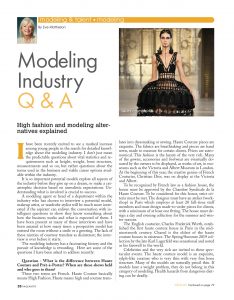High fashion and modeling alternatives explained
I have been recently excited to see a marked increase among young people in the search for detailed knowledge about the modeling industry. I don’t just mean the predictable questions about vital statistics and requirements such as height, weight, bone structure, measurements and so on, but rather questions about the terms used in the business and viable career options available within the industry.
It is so important potential models explore all aspects of the industry before they give up on a dream, or make a catastrophic decision based on unrealistic expectations. Understanding what is involved is crucial to success.
A modeling agent or head of a department within the industry who has chosen to interview a potential model, makeup artist, or wardrobe stylist will be much more interested if the aspirant can enliven the conversation with intelligent questions to show they know something about how the business works and what is expected of them. I have been present at many of these interviews and have been amazed at how many times a prospective model has entered the room without a smile or a greeting. The lack of these niceties of courtesy translate as disinterest; the interview is over before it starts.
The modeling industry has a fascinating history and the pursuit of knowledge is rewarding. Here are some of the questions I have been asked to address recently:
Question – What is the difference between Haute Couture and Prét-à-Porter? When are these shows held and who goes to them?
These two terms are French. Haute Couture basically means High Fashion. Haute means high and couture translates into dressmaking or sewing. Haute Couture pieces are exquisite. The fabrics are breathtaking and pieces are hand sewn, made to measure for certain clients. Prices are astronomical. This fashion is the luxury of the very rich. Many of the gowns, accessories and footwear are eventually donated by the owners to be displayed, as works of art, in museums such as the Victoria and Albert Museum in London. At the beginning of this year, the creative genius of French Couturier, Christian Dior, was on display at the Victoria and Albert.
To be recognized by French law as a fashion house, the house must be approved by the Chambre Syndicale de la Haute Couture. To be considered for this honor, strict criteria must be met. The designer must have an atelier (workshop) in Paris which employs at least 20 full-time staff members and must design made-to-order pieces for clients, with a minimum of at least one fitting. The house must design a day and evening collection for the summer and winter seasons.
The English couturier, Charles Frederick Worth, established the first haute couture house in Paris in the mid-nineteenth century. Chanel is the oldest of the haute couture houses in existence. The Spring/Summer 2019 collection by the late Karl Lagerfeld was sensational and noted as his farewell to the world.
Celebrities and the very rich are invited to these spectacular events. The haute couture model is an exquisite, sylph-like creature who is very thin with very fine bone structure. Many of the models are naturally pencil thin. If models have a weight problem, they do not belong in this category of modeling. Health hazards from dangerous dieting can be deadly.
To read the rest of the Modeling feature… Click Here
To subscribe to Pageantry magazine… Click Here
To follow Pageantry magazine on Instagram… Click Here
To follow Pageantry magazine on FaceBook… Click Here


